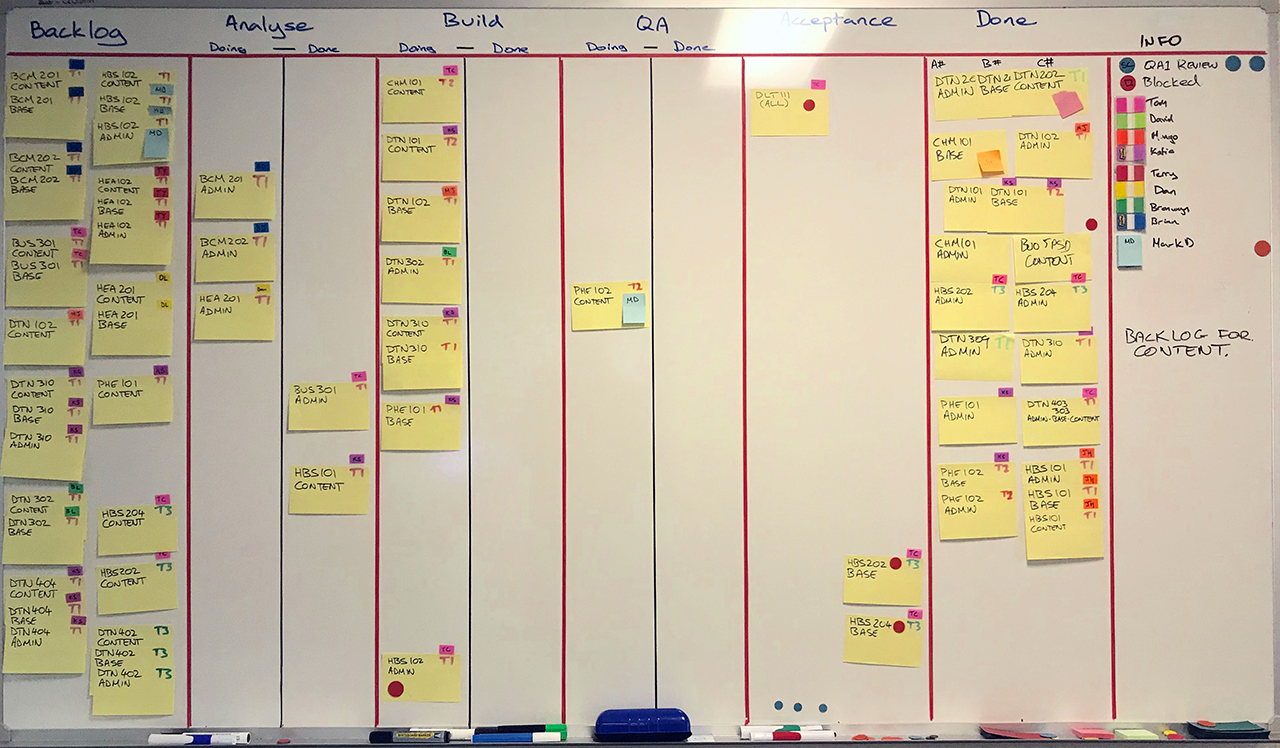“We want you to shift a course from Canvas to Moodle.
The course has 27 subjects. You and your three learning design colleagues have six months.”
Someone Higher Up (may or may not be Bob)
This is the first in a series of posts by Tom Cotton. Read on to learn how they did it.
27 subjects. 4 FTE Developers (Learning Designers). 6 months. Progress must be tracked and reported.
What to do: “Lift & shift” ~ recreate each Canvas subject in Moodle as though they are just about to be rolled over for the new teaching period.
What not to do: Learning Design ~ this is not the time to re-imagine, embellish, restructure subjects or change the content.
The Analysis
When these subjects were initially created in Canvas they had very strong Learning and Design and Development support.
Analysing the subjects to be transitioned showed a diverse range of topics:
- Chemistry
- Physiology
- Health
- Food
- Biology
- Business
- Law
They also use a variety of learning models:
- Direct Instruction (Intensive and 12-week)
- Inquiry Learning
- Problem Based Learning
- Information/Learning Resource
A common structure emerged for each unit:
- Introduction Module
- Non-learning modules
- Standard modules (Subject information, Assessment)
- Non-standard
- Learning modules
The plan of attack
The principles behind the plan of attack:
- Copy and paste is the path to insanity.
- The more we automate, the quicker we get stuff done with more quality.
- We constantly evolve (we don’t make mistakes).
- Openness, peer review and no-fault is the quick path for everyone getting the next task done faster.
The big unknowns:
- How do you automate the migration to Canvas Pages whilst maintaining the integrity of images, links, media etc?
- Will Canvas custom mark-up quirk badly in Moodle?
- Is conversion of quiz questions from Canvas to Moodle even possible?
- How can we best interpret the subject structure from Canvas’ Click-next-of-death to Moodle’s scroll-of-death?
- Any unknown unknowns lurking …
Foundation tasks
- Design a template reflecting the typical Canvas-LMS approach:
- Adapt the standard College Moodle template
- Design a basic learning flow that is flexible to different pedagogical approaches.
- Consult with Project Sponsors on information design
- Convert a subject as Proof-of-concept and discovery of issues.
- Project establishment tasks:
- A project name! (“Project Bob”. Why? Why not?! )
- Dev Environment for Learning Designers: comms, file management, resources and tools, task tracking, process documentation
- Communication: Reporting, Accountabilities, Channels and information.
- Design 3 stage build processes
- Admin Build: Kick off meeting & subject shell + Self QA
- Base Build: Non-learning Modules + 1 Learning module (Self QA, Peer QA and Client QA)
- Content Build (Self QA, Peer QA and Client QA)
- Design content process
- Content conversion
- Question Conversion
- Quiz Conversion
- Hammer away at discovered issues until solutions are found.
Solutions
The tools and infrastructure used to support the project coordination were:
- MS Teams: this was a revelation for the development team where you can create a single context for a project. For Project Bob, a simple tabbed interface allows each team member to switch between Conversations, Project Notes, Project Files, Project Management Tools, Canvas and Moodle. MS Team also integrates video chats (very similar to Zoom or captivate).

MS Teams successfully hides interfaces to SharePoint allowing for Cloud based collaboration (See OneDrive). - MS OneDrive: awesome on a mac; not so on Windows unless careful. Still used to manage document version control.
Why not so hot on Windows? The historical MS DOS / Windows file character limit still exists so that stuffs up OneDrive for Business from working properly nearly 40 years later. La Trobe’s ICT support came to the rescue implementing: https://www.howtogeek.com/266621/how-to-make-windows-10-accept-file-paths-over-260-characters/ - Teamwork: simple but not simplistic project management. As someone who loathes PM tools, this one is actually seems to have the balance right for both managers and do-ers. Used for Kanban board functionality, it also supports my automated Excel tracking reports.
- Kanban Board: Post-it Notes (don’t use genuine imitation ones). This encourages sharing, collaboration and proactivity.

- MS Office: incredibly generic tools for generic project admin tasks
- Excel: summarises Teamwork data into subject status
- Word: Templates, pulled reports from Excel
- Outlook: for comms
- Kubi + Zoom: support the flexible work arrangements of developers working from home: allows active participation in daily stand-up meetings.

main post: A Canvas To Moodle Migration
